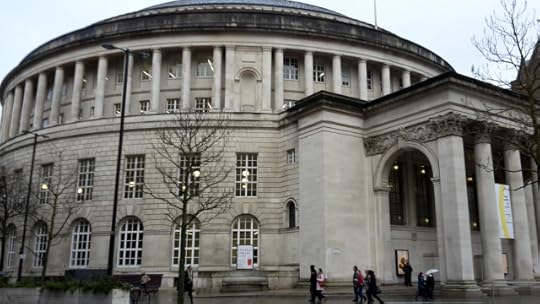Heather Burnside's Blog, page 10
March 31, 2016
The Indie Author’s To Do List
Now that I’ve finished an early draft of my third novel, and sent it off to my beta readers, I’m thinking about the other tasks that I have to complete before publication. I’ve taken a look at the ‘To Do’ lists that I prepared for the previous two books and, to be honest, I could easily become overwhelmed by the sheer amount of work still to be done. There’s the front and back matter, cover design, editing, proofreading, listing with Nielsen and BDS (for libraries), formatting etc. etc. And that’s before I even think about marketing.
The job of an independent author isn’t just to write a novel, but it’s similar to managing a project. However, unlike business projects, which may involve huge teams of people, the independent author is responsible for the whole project from start to finish. Although it is possible to hire help for certain tasks, ultimately, the overall responsibility for delivery rests with the author.
I therefore thought it would be interesting to share a mock-up of a typical Indie author’s to do list. I hope that it might be helpful to others, especially new authors. I personally find a ‘To Do’ list invaluable because you can keep track of exactly where you are up to, and mark off your tasks as you complete them. I use grey highlighting to cover the areas that are completed, and use either bright highlighting or red italics to draw certain items to my attention. In this way I can tell at a glance what jobs still need to be tackled. By breaking tasks down in this way, and keeping track of them, the process will seem less daunting.
The following ‘To Do’ list includes only those tasks that have to be undertaken once you have produced your first draft of the book. Therefore, it refers to those activities that I would normally start organising once my book is with my beta readers. Here goes:
Task
Done
Arrange cover design asap. N.B. Need both a Kindle and a print version.
Front and back matter.
Write online press release.
Allocate an ISBN number and register the book on Nielsen Title Editor website for the print version (takes 3 working days to show), (for the Kindle version Amazon allocate an ASIN number).
Libraries – Register with BDS once book is on Nielsen database: http://www.bibliographicdata.co.uk/ before I publish.
Write a series of blog posts related to the book, which I can publish at regular intervals until publication.
Re-read ‘Slur’ and ‘A Gangster’s Grip’ to make sure there are no inconsistencies in the three books (as it’s a trilogy).
Draw up a list of quotes from the book and from early reviews that I can add to Twitter.
Do a newsletter for people on mailing list announcing the launch (once available for pre-order), telling them about the Goodreads Giveaway & any other launch promotions.
Deal with feedback from beta readers once I receive it (deadline is 11th April).
Edit using editing software.
Arrange proof-reader in advance then do final proofread myself when he has completed it.
Arrange eARCs to all reviewers. Try to give them at least three weeks before I launch. Arrange any interviews.
Format for Kindle, upload, make available for pre-order and announce via newsletter.
Format for CreateSpace – Refer to typesetting instructions under ‘A Gangster’s Grip’ folder.
Upload to CreateSpace. Then approach bookshop with launch date (once I know when I will receive my print copies) & set up promo activities. N.B. Have to order a print proof first and check that before ordering my copies.
Organise a Goodreads Giveaway as soon as the book is published (make sure that the Kindle and print versions are linked together before I do this).
Send for personal copies from CreateSpace once the print version is available (this should cover friends, libraries and book shop signing).
Organise book shop signing. Make sure I have all the promotional materials ready for the signing e.g. A4 display stands for book posters, and that I have sufficient stock of the two previous novels.
Add the book to Booklinker to get the short form link.
Change profiles on WordPress website (all relevant pages), Twitter, Amazon, Goodreads and Facebook to include the new book, and replace old author photos. N.B. Must include the Amazon link once it is available.
Notify everyone about the launch – Twitter (pin launch tweet), schedule a new release tweet for next few days, FB, mailing list, blog, text friends if not active on FB etc.
Organise any ads in relation to any launch or pre-launch promotions (see below).
Once the book is available, possibly organise a book promotion in relation to one or both of the first two books in the trilogy.
Make up a marketing list for any additional promotional activities that may prove fruitful e.g. book trailers, radio interviews etc.
Do sales to libraries – Would have to approach re AGG at the same time as I haven’t done yet.
Your own ‘To Do’ list might vary depending on, for example, whether you are producing a digital or a print version of your book, or both, as well as other factors. However, the above list will hopefully give you some ideas to consider.
——————-


March 22, 2016
John Rylands Library

John Rylands Library
In the last of my posts about historic libraries of Manchester, we will take a look at the John Rylands library, a neo-Gothic building situated on Deansgate in the city centre. The John Rylands library is now part of the University of Manchester, but it is open to visitors. It houses one of the most unique collections in the world, consisting of 1.4 million items collected from numerous countries, and covering a period of over 5000 years. The items include more than 250,000 printed books.
Although the building is a little dark and formidable in appearance, I personally think that the beauty of many Gothic buildings lies in the detail rather than the overall impression. It also has a much more attractive interior.

John Rylands Front Entrance

John Ryland Exhibition Gallery
History
The library opened on 1st January 1900. It took ten years to build and was founded by Enriqueta Rylands in memory of her late husband, John Rylands. She commissioned architect Basil Champneys to design the building in 1889 after being inspired by his design of Mansfield College in Oxford.
Enriqueta Rylands purchased Lord Spencer’s Althorp Library of 43,000 items in 1892, which was then regarded as one of the finest private collections in the world, with 3,000 of the items dating from before 1501. This collection made up the original stock for the John Rylands library at a purchase price of £210,000.
Since then further collections have been added to the library’s stock including:
The addition of Richard Copley Christie’s library of 8,000 volumes in 1901, which includes many rare books from the Renaissance period N.B. This was originally acquired by the University of Manchester, but was transferred to the John Rylands library following the merger with the university in 1972.
The purchase in 1901 of 6,000 manuscripts formerly owned by James Linsay, 26th Earl of Crawford, which was one of the rarest collections in Britain at that time
5,000 items bequeathed by Walter Llewellyn Bullock in the 1930s, which are early Italian imprints
The library has Grade 1 listed status. It merged with the University of Manchester in 1972 and now houses special collections from both the John Rylands library and the university.

John Rylands Stained Glass Window
John Rylands
John Rylands was an industrialist who rose from humble beginnings to become Manchester’s first multi-millionaire. Together with his father and two brothers, he founded a textile company during the Victorian era. The company produced cotton goods and, at its peak, it owned 17 mills and factories, and employed 15,000 people.
Originally from St Helens, John Rylands moved to Manchester in 1834. By 1855 he had moved out of the city centre and into the suburbs. He bought Longford Hall in Stretford where he kept a library of books, which were mainly religious. On his death in 1888 he left over £2.5 million.
The Collection

John Rylands Rare Collection
John Rylands library now has a collection of over 250,000 books and well over a million items in total. These consist of an amalgamation of items from the John Rylands library and the University of Manchester’s rare collections. It is regarded as one of the finest collections of books, manuscripts and archive items in the world.
The collections span more than 5000 years, cover more than 50 languages and include a vast range of subjects. There are hundreds of archives from businesses, landed families, charities, trade unions and business associations. Papers from well-known scientists and academics are also housed here.
Other items worthy of mention are the medieval illuminated manuscripts, early printing including books printed by William Caxton and a fine paper copy of the Gutenberg bible, and the personal papers of historical figures such as Elizabeth Gaskell, John Wesley and John Dalton.
Present Day
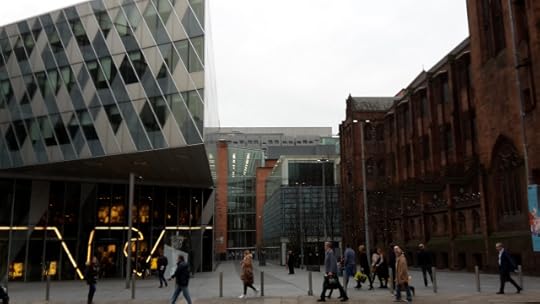
John Rylands Extension
The building was refurbished between 2003 and 2007 at a cost of over £17 million. This was funded by a grant of 8.5 million from the Heritage Lottery Fund and £3 million from the European Regional Development Fund together with other funding. This funding provided enhanced facilities for both visitors and readers. The new facilities include exhibition galleries on the ground floor and a Special Materials Reading Room. The funding also financed conservation work to the building. Personally, I’m not too keen on the modern addition to the building but I suppose it’s all a matter of taste.
———————-


February 24, 2016
Beta Readers Wanted
I’m looking for Beta readers for my latest novel, which is the third part in the Riverhill Trilogy. Although it’s part of a trilogy, it can be read as a standalone novel. The book is a mystery based crime thriller, and the Riverhill Trilogy fits into a sub-genre known as grit-lit so there is a certain amount of violence, drugs, bad language etc. Here is the blurb to give you more of a feel of what the novel is about:
Rita has been avoiding Manchester; it brings back too many bad memories. She still has harrowing flashbacks of ruthless gangster, Leroy, and the death of a loved one. It takes the wedding of her brother, John, to persuade her to return. She agrees, on the condition that she steers clear of the Riverhill estate and Leroy’s family.
When her son, Jake, is placed in danger, Rita is lured back to the Riverhill where she confronts those she believes responsible. She receives support from an unlikely source who promises information subject to terms. Realising that she needs help to act on that information, Rita turns to her brother, John.
But John works for the law. And he will have to go against everything he believes in if he agrees to embark on a maverick mission to help save his sister’s son.
You can also check out the first two books in the trilogy, ‘Slur’ and ‘A Gangster’s Grip’. Here are the links: http://viewbook.at/Slur and http://viewbook.at/GangstersGrip.
I hope to have the book ready to send off to beta readers in the next couple of weeks. If you are interested, please drop me an email at: [email protected].
——————


February 4, 2016
The Writer Behind the Words
The new Budweiser advert for the American Super Bowl is causing quite a stir. In it, Dame Helen Mirren warns viewers against the foolishness of drink-driving. Here’s the link if you want to check it out: Budweiser ad 2016.
Helen Mirren opens the ad by describing herself as a ‘notoriously frank and uncensored British lady’ while regal music plays in the background. She then goes on to launch an articulate tirade of insults against anyone who drink-drives.
She is the perfect choice for the advertisement; a commanding figure who previously played the starring role in ‘The Queen’. Her delivery is undoubtedly excellent. The words convey the message perfectly while the accompanying video footage advertises Budweiser beer by displaying Dame Helen’s enjoyment of a Bud with burger and fries. The words to the advertisement may even have been written with Dame Helen Mirren in mind.
While she may describe herself as ‘notoriously frank and uncensored’ in the ad, the British press have proudly used a range of descriptions for her including, ‘elegant and eloquent’. But it made me wonder who the person behind the words is. This thought often runs through my mind when watching TV. Something will capture my imagination and I’ll think, ‘that’s a clever bit of writing’.
It’s something that people often lose sight of; behind every TV advertisement, film, drama, documentary, billboard ad etc. there is a writer. Ironically, while actors and actresses are lauded for their performances, the writers who supply their words are seldom mentioned. I checked the media coverage of several newspapers and TV channels for the Budweiser advertisement, yet not one of them mentioned the writer. In fact, they didn’t even mention which advertising company Budweiser had used to produce the advertisement.
So, what other media are writers involved in?
Ooh, just about everything: TV, radio scripts, cinema, theatre, billboard campaigns, mailshots, email campaigns, the Internet and social media. In fact, major companies employ copywriters specifically to manage their social media accounts as well as produce regular blog posts for their websites. Even prime ministerial and presidential speeches are penned by writers; people who are employed to write speeches on their behalf.
If I was to ask you to name the best speech of all time you would probably say Martin Luther King, ‘I Have a Dream’, or the Obama Victory Speech of 2008. But what if I was to ask you who wrote those speeches? The majority of people wouldn’t know. Incidentally, the memorable part of Martin Luther’s ‘I Have a Dream’ speech was probably written by himself although he delivered it without referring to the text. You can read the full story here: I Have a Dream Speech.
Writers are the people who hide in the background but are behind so many impactful words that many of us will retain in our memories for years to come. Many writers prefer it that way. We are often shy and retiring types, and I for one have no desire whatsoever to appear on the stage. But wouldn’t it be nice if, in circumstances such as the above, the writer received even a one line mention in acknowledgement of his/her input.
———————-


February 1, 2016
The Illness that Impacts my Writing Life
I recognise the signs straightaway. First comes the nausea accompanied by dizziness. The dizziness is there throughout, but sometimes it’s accompanied by a weird, frightening sensation. It’s as though the whole room has suddenly shifted, and I have to grab hold of something to stop me falling over. Then comes the headache. It’s defined as a headache, but it’s much more than that. A constant hammering that won’t go away. An oversensitivity to light and sound. Shakiness. Irritability with everybody and everything. Small tasks become a major chore. Conversations become onerous. And I just want to take to my bed; the only answer to migraine, it seems.
I try not to take to my bed though. I resent the timewasting, especially as these attacks are the consequence of something that is supposed to be a natural occurrence; the menopause. Besides, once is starts I know that I will feel like this every day for at least a week. I can’t afford to waste that much time.
They come in varying degrees; some are worse than others. Yesterday was a bad one, accompanied by a swollen and upset stomach. It lasted for most of the day, and I did take to my bed. I came down later to hang the washing up. Although I was over the worst, I still struggled to carry the basket upstairs. I was so dizzy that I felt as though the weight of it was pulling me over. My husband said I should have asked him to do it, but how could I when he had already done everything else that day?
I’ve been feeling this way for six years. The first year was bad, then I had a break of a year and I foolishly thought it was all over. It came back with a vengeance and I’ve been stuck with migraines ever since, apart from one three month break.
It changes pattern too. For a while I was well for two weeks out of three, and I could pretty much predict when my ‘sick’ week was going to be. Then it went to one week in two. Now I seem to be ill more often than I’m well. My last lengthy spell lasted two weeks followed by a break of just three days. Then I had two days of mild migraines followed by a five day break. Now it’s started again.
Most days I can work through it once I have taken sufficient medication. As I’m typing this, I feel nauseous, my head is pounding and the bright white background of my computer screen is forming strange shapes, which are dancing around on the screen. I also keep making typing errors that I wouldn’t otherwise make so I have to keep going back and correcting them. But I’m determined not to give into it. I have the light on my PC turned down low but it still affects me. I’m waiting until I can take a second Sumatriptan so I can see if I will then feel well enough to tackle some of my book this afternoon.
I’m currently taking Sumatriptan mostly, and 25mg of Topiramate in the evenings. I don’t like Topiramate, and have gradually reduced my intake. It’s an anti-epileptic drug, which seems to make me more forgetful and affects my concentration. Unfortunately, there is no specific preventative drug for migraines so doctors experiment with various drugs until they find something that works.
I have tried various medications but nothing prevents them. I’ve just changed my HRT in the hope that it might help. Saturday I had a lovely day and commented to my husband that I was beginning to feel like my old self. There was a shred of hope that maybe the new HRT would solve the problem. But then it all started again on Sunday.
When I’ve had a bad run of migraine, I become forgetful and my concentration is poor. Then there’s the confusion. I’ve only had one episode of confusion, but it was scary. I take medication for several other health problems – five tablets each evening in all. As I take them I always make a mental check so that I take the right ones in the correct amounts e.g. this one’s Montelukast for my asthma, this one’s Fexofenadine for my allergies etc. One evening I went to take my tablets, but when I read the names on the bottles and packets, they meant nothing to me. I didn’t recognise any of them. It really freaked me out. About two hours later I had a migraine attack. My doctor told me that it was the aura, which presents itself in different ways.
Then there’s the emotional side. When I’ve been feeling ill for days it gets me down, naturally. This illness doesn’t just impact on my writing life but on every aspect of my life. I become short and snappy with my family. I have to cancel nights out because of illness. In fact, I don’t make many arrangements to see friends anymore. It’s a waste of time as I never know when I’m going to be well.
With frequent migraines it’s a challenge to manage my working life without thinking about anything else. It makes it difficult to think straight. It stifles creativity. It takes the pleasure out of every situation, and turns everything into a major chore.
I also become angry. On a bad day I think ‘why me?’ And if a middle-aged, menopausal woman moans about hot flushes, I feel like screaming at her that she ought to be grateful if that’s her only symptom of the menopause. I get angry at smug celebs on TV who boast about how they sailed through the menopause by taking the natural approach. They encourage others to do the same, but how do you take the natural approach when cooking a nutritious meal feels like a mammoth task half the time?
But the determined side of me tries to be positive. It’s only migraine, and it’s menopausal so it won’t last forever. If I’ve had it for six years then surely it must be coming to an end soon. There are many people worse off than me; people with terminal illnesses, for example.
Although it impacts my working life, I’m lucky with my choice of career. I know that I wouldn’t be able to hold down a full-time office job, for example. I’d either be off sick or shouting at everybody in the office to leave me alone. So, I’m fortunate that I work from home, and I can put things off if I’m feeling particularly bad.
As I’m now earning a salary from my books, I’ve cut down drastically on my client work. This is because anything that’s deadline driven is difficult, as I never know when I’m going to be ill. However, with my books, even if I have a bad writing day, I can go back and correct any errors when I’m feeling on top of things.
When I look back at this post I’ll probably cringe with embarrassment at the ‘poor me’ implications. But today I’m at the start of a migraine spell and I’m feeling disheartened at the thought that it might last two weeks again. And I just want to crack on with my next book! If anyone has any suggestions for tackling hormonal migraine, they will be most welcome.
————-


January 25, 2016
The Portico Library
The Portico Library is situated on the corner of Mosley Street and Charlotte Street in Manchester, and shares the building with a pub called the Bank. The pub was named after the Bank of Athens, which previously leased the building. Visitors can’t fail to spot the impressive Mosley Street entrance, which has a grand façade in the Greek revival style with four stone pillars.

Dome image: http://relishreads.com
Although the Mosley Street entrance looks rather impressive, this is, in fact, the pub entrance. The library entrance is round the corner at Charlotte Street, and appears more modest. I haven’t been inside the library but, from what I have read, I think it would be worth exploring.
Unlike the other libraries that I have featured in this series of blog posts, the Portico Library is a private members’ library. However, it also hosts events and exhibitions that are open to the general public, and certain areas of the library are available for venue hire. The gallery area and cafe are open to non-members as well, and are situated beneath a stunning Georgian glass and plaster dome.
Membership

The Portico Entrance
For an annual fee, members have exclusive access to the Reading Room, Reading Corner and Cobden area. They can borrow books from the library’s collection, which mainly dates back to the 19th century. The collection focuses on the Georgian and Victorian era of Manchester during a time of great affluence in the city. It includes first editions by a number of authors including Charles Dickens, Elizabeth Gaskell and Wilkie Collins.
Membership fees start at £58 per annum for young members up to £184 per annum for a town membership. There is also a lifetime membership option, and a one off administration fee of £30 has to be paid by each member.
History
The library is housed in a grade ll listed building, which was constructed between 1802 and 1806. It was designed by Thomas Harrison, the architect who also designed the Lyceum in Liverpool. The Portico is a Greek revival building with four Ionic  columns, and it was built from sandstone ashlar.
columns, and it was built from sandstone ashlar.
An interesting fact is that the first secretary of the library was Peter Mark Roget who began work on his thesaurus during his time there. And there you have it: Roget’s Thesaurus. (No wonder our schoolteachers used to harp on about it being the best thesaurus you could buy. They were displaying their loyalty to Manchester, of course.) Their teachings have stuck – here’s my battered old copy.
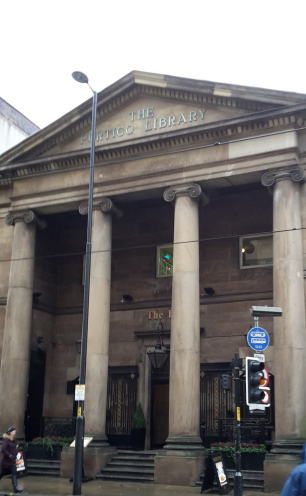
The Bank Entrance
Events
The library hosts a range of events and exhibitions, which are available to the general public as well as to members. Events are usually charged but entrance to art exhibitions is free. Members generally pay a reduced rate to attend events. Typical events include readings, talks, special interest evenings (often with a literary theme) and the hosting of literary competitions. Specific areas of the library can also be hired for private functions.
The Portico Prize
The Portico Library hosts three competitions: The Portico Prize for Literature, The Portico Poetry Prize and the Young Readers and Writers. The competitions take place on alternate years, and are intended to celebrate writers and poets from the north of England.
Described as the North’s leading literary award, the Portico Prize for Literature is backed by Arts Council England and The Zochonis Charitable Trust. It offers a £10,000 first prize, and Val McDermid is a former winner.
This is a fabulous opportunity for writers, and I’ve promised myself that I will enter the competition in the future as well as attending some of the events hosted by the library.
———————-


January 11, 2016
Bowie Tribute
There’s a legend gone up to the sky
He wrote fantastic music
And his talent blew my mind
There’s a legend gone up to the sky
It’s sad he had to go now
But his presence was worthwhile
He taught me:
Express yourself through lyrics
Express yourself through music
We won’t forget his music
—————
So sad to hear the news today. R.I.P David Bowie.
—————


January 8, 2016
Liebster Award
Big thanks to Brigid at Brigid Writes Things for nominating me for a Liebster Award. The Liebster is an award that bloggers give to each other as a way to promote blogs with less than 1,000 followers. It’s also a fun get-to-know-the-blogger tag!
The Rules:
Thank the person who nominated you and link their blog.
Answer the 11 questions the nominator has given you.
Tag 11 bloggers who have less than 1,000 readers.
Think of 11 questions to ask the bloggers you have nominated.
Let them know you’ve nominated them through social media or their blog.
Brigid’s Questions (and My Answers)
Put your music on shuffle. What are the first five songs that come up?
‘Old Fashioned’ by Cee Lo Green, ‘Promise This’ by Cheryl Cole, ‘Last Night a DJ Saved My Life’ by Indeep, ‘All the Time in the World’ by Boyzone and ‘More than a Woman’ by the Bee Gees. Cringe! OK, I admit it, I still play CDs and I haven’t updated my iPod for a while. I’m an 80s throwback.
What’s the last thing that made you laugh really hard?
I go to a Spanish group once a week and we do nothing but laugh although we are supposed to be learning. It’s just general banter, mispronunciations and misinterpretations etc.
What’s something you did in 2015 that you’re proud of?
I published my second novel, and I finally became visible to the book-browsing public on Amazon UK. I’m keeping my fingers crossed that it continues.
What’s one thing you hope to accomplish in 2016?
To publish my third novel, which is the third and final part of The Riverhill Trilogy.
Do you enjoy going to concerts? If so, what was the last one you went to?
I’m not a big concert goer. I think the last one I went to was probably Rihanna.
What is one of your favorite quotes?
‘No les illegitimi carborundum.’
What is the weirdest food you like?
Sushi and seafood according to my family.
What book has made you cry the hardest?
I honestly can’t remember a book making me cry but I don’t generally go in for weepy novels.
What was the best day of your life?
The day I gave birth for the first time.
What fictional world would you love to live in (or at least spend some time in)?
None. I’m very grounded in the real world and think that there is enough good and bad in the world without looking for it elsewhere.
If you could meet any author (living or dead), who would it be?
As much as I love reading, I’ve never really thought about meeting authors. I suppose it would be someone like Jeffrey Deaver or Minette Walters but then I wouldn’t know what to say to them other than ‘I think your books are great’.
My Nominees:
Georgia Rose at Georgia Rose Books
Linda Huber at Linda Huber Author
Guy Portman at Author Guy Portman’s Blog
Marilyn Chapman at Guernsey Girlie
Katherine Jenkins at Katherine’s Bookcase
Kath Middleton at Ignite Books
Mark Barry at The Wizard’s Cauldron
Geoff West at My Blog
My Questions:
What makes you happy?
Who are your favourite authors?
What genre do you like to write in, and why? (This one is for writers only).
What are your favourite genres to read, and why?
What was the best day of your life? (I pinched this one from Brigid)
In general, do you think books are best portrayed through films or through the book itself?
What place in the world would you most like to see, but haven’t yet got round to visiting?
What’s your favourite form of transport, and why?
Do you have a writing goal i.e. something that you would like to achieve through your writing? If so, what is it? (This one is for writers only).
What is your all-time favourite book?
What is your biggest passion (apart from writing)?
I just want to finish by saying that if you are unable to take part it isn’t a problem, and thanks again to Brigid for nominating me. Also, please don’t be offended if I’ve nominated you and you have more than 1000 followers as it isn’t always possible to tell.
In future blog posts I will be continuing the theme of Manchester’s historic libraries, with two still to come. I wonder if you can guess which ones they are. Bye for now and have fun with the questions and answers.
——————


December 29, 2015
Why Thinking Time is Important for Authors
Recently, while writing my third novel, I reached a bit of a standstill. I was following the outline that I had written but it felt a little like painting by numbers, and I didn’t have the enthusiasm that I had for A Gangster’s Grip. In fact, because of this situation I had put off writing for a few days.
With my first two books I was so enthusiastic that the ideas were spilling out of me. I would wake up with an idea for a scene later on in the book or it would form while I was out at the shops or taking a shower. However, with my third novel things were different. 18,000 words in and this still wasn’t happening. To complicate matters, I needed to do some primary research but I didn’t want it to halt my flow while I was waiting for the answers.
 In my search for inspiration I started reading a James Patterson novel and going over some of the notes from my writing course, but it still wasn’t happening. So, I put the books to one side, lay down on my bed, shut my eyes and thought about the plot so far.
In my search for inspiration I started reading a James Patterson novel and going over some of the notes from my writing course, but it still wasn’t happening. So, I put the books to one side, lay down on my bed, shut my eyes and thought about the plot so far.
What had happened up to now? What direction was the novel heading in? How could I inject some suspense and excitement on the way to reaching my final destination (as I already had the ending worked out)? How could I write my way around the scenes requiring research while I awaited answers to my research questions?
N.B. You’ll note that I refer to ‘scenes’ rather than ‘chapters’ because I like to think of ‘scenes’ while I am writing. This helps me to visualise what is taking place. I haven’t yet allocated chapters but I will come to that later. With my first two books I divided them into chapters as I went along but then found that I had to make some alterations at the end, so I’m trying a slightly different approach this time.
Whilst lying on my bed I went over the scenes I had already written in my mind. Then I started thinking about the scenes that were to follow. I decided to write the next scene based on assumptions but highlight it so that I could easily make changes once I had received the answers to my research questions. Once I had decided how to go forward with that scene, I found that the rest fell into place, and ideas started to form for subsequent scenes. I picked up my small notepad and within a half hour I had several pages of notes.
That half hour or so was worth so much more than hours spent at a computer keyboard willing the ideas to come. It’s great to be able to sit at the computer and hammer away on the keys when you already have a few pages of notes to guide you along. The notes should keep me going for a few more thousand words but if I come unstuck again, I’ll try employing the same tactic.
I’d love to hear from other authors regarding this topic. Have you ever come across a similar problem and, if so, how have you tackled it?
—————————


December 16, 2015
Fancy Getting Married in a Library?
It’s a book lover’s dream, but hopefully one that is shared by your other half. Even if you’re not both book lovers, Manchester Central Library is still a stunning venue in which to hold a wedding. An extreme enthusiasm for books and libraries will help though when it comes to footing the bill.
The package costs £15,000 for 50 daytime guests and 50 evening guests, with an additional cost of £125 per daytime guest and £30 per evening guest. The maximum number of guests that can be accommodated is 80 in the daytime and 120 in the evening.
You do get a lot for your money though including exclusive use of the library on a Sunday, five course wedding breakfast, evening reception and a champagne toast. You also get access to the Wolfson Reading Room and other heritage spaces. Judging by the photographs in the brochure I think some of these areas are private rooms that aren’t usually available to the public. There are also lots of other touches, but rather than sounding like an advertising brochure, I’ll just give you the link so you can download the very impressive pdf: Central Library Wedding Brochure.

The skylight on the inside of the dome
Manchester Central Library
As the name suggests, it is the headquarters of Manchester libraries. Although it doesn’t have the same historic significance of some of Manchester’s older libraries, nevertheless it is a grade II listed building, which was constructed between 1930 and 1934. The design itself is eye-catching and was loosely based on the Pantheon in Rome.
The library was closed from 2000 until March 2014 while extensive renovations took place at a cost of £40 million. As part of the renovations the Library Theatre Company moved out of the library basement and into its new premises at HOME, a centre for international contemporary art, theatre and film at First Street, Manchester. This was following a merger with the Cornerhouse, a centre for cinema and the contemporary visual arts.
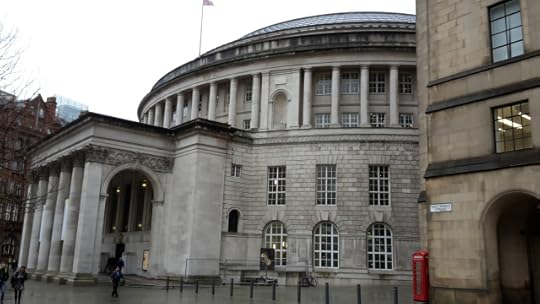
The building to the right is the Town Hall Extension
Manchester Central Library is the second largest public lending library in Britain. It has a host of facilities as well as dramatic design features. Personally, I prefer the original architecture and am not so keen on the glass paneling that has been added following the recent renovation, but I guess I’m an old fashioned (old) girl at heart.
Just some of the facilities include:
Free use of computers for up to one hour.
Free Wi-Fi connection.
A media lounge with creative software and gaming stations.
Services for the visually impaired including assisted technology and software.
A business centre giving advice to help you start or run your own business.
Rare books and special collections.
The Henry Watson Music Library where you can play or record your own music.
The Ahmad Iqbal Ullah Race Relations library, which specialises in the study of race, ethnicity and migration.
A café.
Oh, and did I mention that you can borrow books, DVDs and audio too?
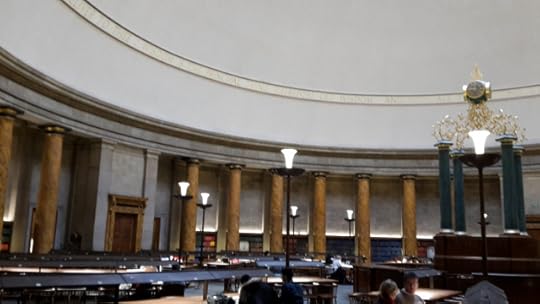
In terms of the architecture, the interior is as striking as the exterior. It was difficult to capture the internal dome by camera but each of these marble pillars is about 1.5 to two feet in diameter. The inscription around the inside of the dome is from the Book of Proverbs in the Old Testament and reads:
‘Wisdom is the principal thing; therefore get wisdom, and with all thy getting get understanding. Exalt her and she shall promote thee; she shall bring thee to honour when thou dost embrace her, she shall give of thine head an ornament of grace, a crown of glory she shall deliver to thee.’ Proverbs 4:7



Shakespeare Hall has stained glass windows including one of Shakespeare and scenes from his plays. The ceiling shows the arms and crests of the Duchy of Lancaster, the See of York, the See of Manchester, the City of Manchester, and Lancashire County Council. As you move out of Shakespeare Hall and up the stairs to the first floor you pass a lovely statue made from white marble, which was presented to the library by the family of the late industrialist and promoter of the Manchester Ship Canal, Daniel Adamson. It is called ‘The Reading Girl’ and is by the Italian sculptor Giovanni Ciniselli.
Manchester Central Library is not the only library that can be hired as a wedding venue. It seems that it has now become a popular trend, and a quick search of Google shows that the Bodleian Library in Oxford, Manchester’s historic Portico Library, The Signet Library in Edinburgh and various other libraries in the UK can be hired. In fact, hitched.co.uk published an article about library wedding venues, which you can read here. It strikes me as a good idea if you’ve got the cash to spare because some of these buildings provide a stunning setting.
—————-














